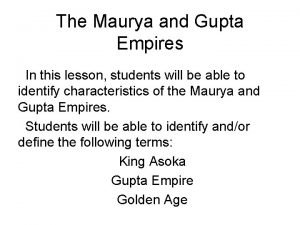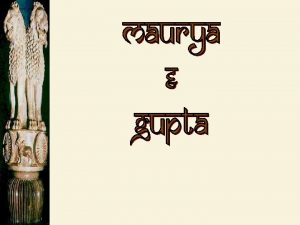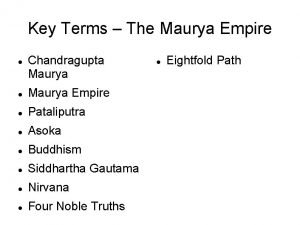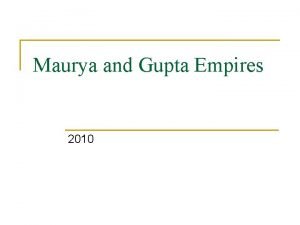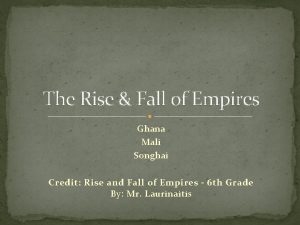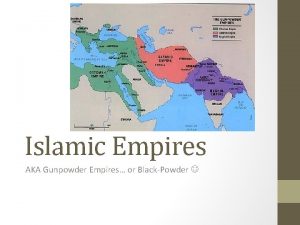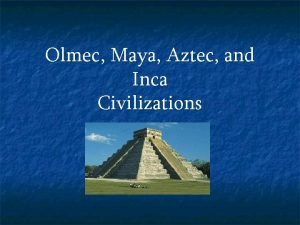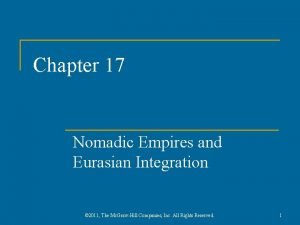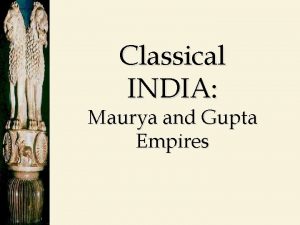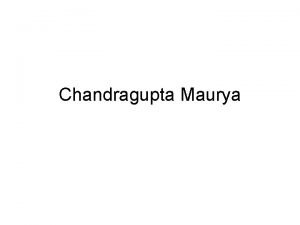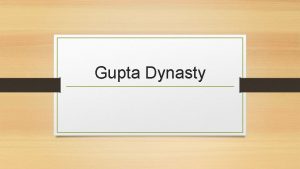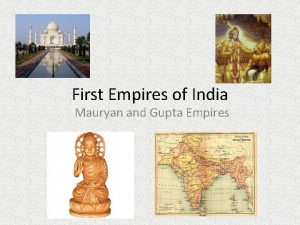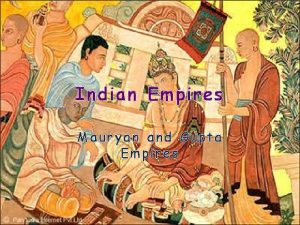The Maurya and Gupta Empires In this lesson














- Slides: 14

The Maurya and Gupta Empires In this lesson, students will be able to identify characteristics of the Maurya and Gupta Empires. Students will be able to identify and/or define the following terms: King Asoka Gupta Empire Golden Age

Do you recognize which modern nation the Mauryan empire was located in?

The Mauryan Empire • Around 323 B. C. , a great empire emerged in northern India. It was called the Mauryan empire. • The rulers of this empire conquered most of northern and central India. • It was a vast empire.

While there were many significant rulers, King Asoka was the greatest ruler of the Mauryan empire. King Asoka converted to Buddhism after witnessing a particularly bloody battle.

King Asoka • King Asoka was the greatest ruler of the Mauryan empire. He converted to Buddhism after witnessing a particularly bloody battle. • King Asoka was religiously tolerant. He respected all religions. • He improved roads, built hospitals, and sent teachers throughout the empire to encourage education and spread Buddhism.

King Asoka was a religiously tolerant ruler. He respected all religions. He ruled a vast empire and he ordered the building of roads and hospitals.

King Asoka encouraged teachers to spread Buddhism throughout India and beyond.

The Collapse of the Mauryan Empire • The Mauryan empire began to weaken after the death of King Asoka. • The last emperor was assassinated around 185 B. C. • Five centuries of disorder followed.

Around 320 A. D. , another great Indian empire emerged. It was known as the Gupta empire.

The Gupta Empire • The rulers of the Gupta empire encouraged peace, prosperity, and trade. • The Gupta empire is considered a golden age of Hindu culture. • A golden age is a time of peace, prosperity, and great achievements.

During the Gupta empire, Indian mathematicians made great advances. They discovered the concept of zero and the decimal system.

The Golden Age of Hindu Culture • The Gupta empire is considered a golden age of Hindu culture. • Hindu mathematicians developed the concept of zero, the decimal system, and the concept of infinity. • Great works of Hindu literature were produced.

Indian artists created beautiful works of art and great works of literature were produced during the golden age of Hindu culture.

Questions for Reflection: • Who was King Asoka and why did he convert to Buddhism? • List three accomplishments of King Asoka. • What is a golden age? • Why is the Gupta Empire considered a golden age? • List three accomplishments of Indian mathematicians during the Gupta empire.
 The maurya and gupta empires
The maurya and gupta empires The maurya and gupta empires
The maurya and gupta empires The maurya and gupta empires
The maurya and gupta empires Mauryan empire and gupta empire venn diagram
Mauryan empire and gupta empire venn diagram Maritime empires vs land empires
Maritime empires vs land empires Chandragupta maurya definition
Chandragupta maurya definition Lean platno
Lean platno Chandragupta maurya ruled for _____years.
Chandragupta maurya ruled for _____years. What phrase best describes the eastern and western ghats
What phrase best describes the eastern and western ghats Marco polo accomplishments
Marco polo accomplishments Imperyong ghana meaning
Imperyong ghana meaning How did the ottoman safavid and mughal empires arise
How did the ottoman safavid and mughal empires arise Aztec olmec maya and inca empires
Aztec olmec maya and inca empires The policy of establishing colonies and building empires
The policy of establishing colonies and building empires Chapter 17 nomadic empires and eurasian integration
Chapter 17 nomadic empires and eurasian integration

